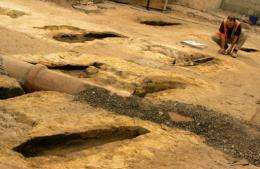Australian archaeologists uncover 40,000-year-old site

Australian archaeologists have uncovered what they believe to be the world's southernmost site of early human life, a 40,000-year-old tribal meeting ground, an Aboriginal leader said Wednesday.
The site appears to have been the last place of refuge for Aboriginal tribes from the cannon fire of Australia's first white settlers, said Michael Mansell of the Tasmanian Aboriginal Centre.
The find came during an archaeological survey ahead of roadworks near Tasmania's Derwent River and soil dating had established the age of the artefacts found there.
"When the archaeological report came out it showed that (life there) had gone back longer than any other recorded place anywhere else in Tasmania, dating back to 40,000 years," Mansell told AFP.
Up to three million artefacts, including stone tools, shellfish fragments and food scraps, were believed to be buried in the area, which appeared to have been a meeting ground for three local tribes.
They died out after white settlers arrived in the late 18th century.
"They (settlers) hunted people here to this place and shot them just so they could get the land," said Mansell. "Many others were imprisoned until they died."
"In terms of culture and history this region now represents Tasmania's Valley of the Kings," he added, referring to the world heritage listed Egyptian tombs on the west bank of the Nile.
"When you get something like this that evokes memory of what your people did before we were born and evokes a memory about the legacy that they left us ... it makes the place irreplaceable."
The survey was finished last week and chief archaeologist Rob Paton said he had been surprised at the age of the items found.
"We haven't even done a reading on the bottom sample yet, I was expecting 17,000 (years) for the base of the trench and about 4 or 5,000 (years) for the top," Paton told state radio.
Paton said luminescence readings -- measuring the age of the artefacts based on how much exposure they had received to sunlight -- had been "nice and statistically tight".
"That suggests to me that they're probably correct, giving us a top reading of 28,000 (years old) and certainly seeming to go back another 10,000 (years) at least beyond that," he said.
The readings indicated that "we do have the oldest, most southern site anywhere in the world", said Paton, making it "an important site for anyone and quite exciting for us".
"I think the thing to stress is no matter what the age of the site it's important anyway," he added.
Mansell said the tribes were famous for their defiant stand against the settlers, and so frustrated the authorities they ultimately issued an order that any Aborigine in the area be shot on sight.
He said the dig's findings were merely the "tip of the iceberg" and called for plans to build a bridge over the site to be scrapped.
"The Tasmanian government must immediately declare it a protected site, not just for Aboriginal people but for peoples of the world," said Mansell.
Australia's original inhabitants, with cultures stretching back tens of thousands of years, are believed to have numbered around one million at the time of white settlement.
There are now just 470,000 out of a population of 21 million and Australia's most impoverished minority.
(c) 2010 AFP
















